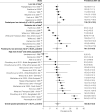A systematic review and meta-analysis of the prevalence of chronic widespread pain in the general population
- PMID: 26270591
- PMCID: PMC4711387
- DOI: 10.1097/j.pain.0000000000000314
A systematic review and meta-analysis of the prevalence of chronic widespread pain in the general population
Abstract
Chronic widespread pain (CWP) is common and associated with poor general health. There has been no attempt to derive a robust prevalence estimate of CWP or assess how this is influenced by sociodemographic factors. This study therefore aimed to determine, through a systematic review and meta-analysis, the prevalence of CWP in the adult general population and explore variation in prevalence by age, sex, geographical location, and criteria used to define CWP. MEDLINE, Embase, CINAHL, and AMED were searched using a search strategy combining key words and related database-specific subject terms to identify relevant cohort or cross-sectional studies published since 1990. Included articles were assessed for risk of bias. Prevalence figures for CWP (American College of Rheumatology criteria) were stratified according to geographical location, age, and sex. Potential sources of variation were investigated using subgroup analyses and meta-regression. Twenty-five articles met the eligibility criteria. Estimates for CWP prevalence ranged from 0% to 24%, with most estimates between 10% and 15%. The random-effects pooled prevalence was 10.6% (95% confidence intervals: 8.6-12.9). When only studies at low risk of bias were considered pooled, prevalence increased to 11.8% (95% confidence intervals: 10.3-13.3), with reduced but still high heterogeneity. Prevalence was higher in women and in those aged more than 40 years. There was some limited evidence of geographic variation and cultural differences. One in 10 adults in the general population report chronic widespread pain with possible sociocultural variation. The possibility of cultural differences in pain reporting should be considered in future research and the clinical assessment of painful conditions.
Conflict of interest statement
Sponsorships or competing interests that may be relevant to content are disclosed at the end of this article.
Figures



References
-
- Ablin JN, Oren A, Cohen S, Aloush V, Buskila D, Elkayam O, Wollman Y, Berman M. Prevalence of fibromyalgia in the Israeli population: a population-based study to estimate the prevalence of fibromyalgia in the Israeli population using the London Fibromyalgia Epidemiology Study Screening Questionnaire (LFESSQ). Clin Exp Rheumatol 2012;30:39–43. - PubMed
-
- Aggarwal VR, McBeth J, Zakrzewska JM, Lunt M, Macfarlane GJ. The epidemiology of chronic syndromes that are frequently unexplained: do they have common associated factors? Int J Epidemiol 2006;35:468–76. - PubMed
-
- Bannwarth B, Blotman F, Roué-Le Lay K, Caubère JP, André E, Taïeb C. Fibromyalgia syndrome in the general population of France: a prevalence study. Joint Bone Spine 2009;76:184–7. - PubMed
-
- Barendregt JJ, Doi SA, Lee YY, Norman RE, Vos T. Meta-analysis of prevalence. J Epidemiol Community Health 2013;67:974–8. - PubMed
Publication types
MeSH terms
Grants and funding
LinkOut - more resources
Full Text Sources
Other Literature Sources
Medical
Miscellaneous

